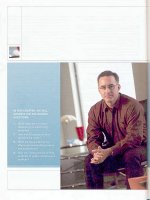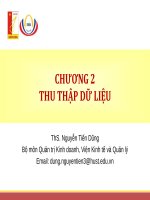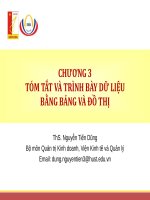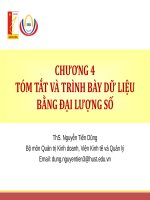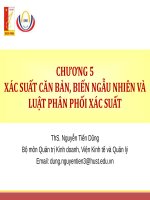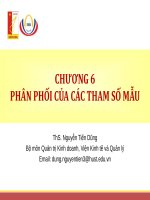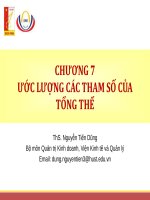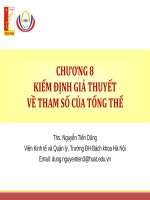Lectures Marketing management: Chapter 18 - ThS. Nguyễn Tiến Dũng
Bạn đang xem bản rút gọn của tài liệu. Xem và tải ngay bản đầy đủ của tài liệu tại đây (1.21 MB, 39 trang )
CHAPTER 18
MANAGING MASS COMMUNICATIONS: ADVERTISING,
SALES PROMOTIONS, EVENTS AND EXPERIENCES,
AND PUBLIC RELATIONS
Nguyen Tien Dung, MBA
Email:
Chapter Questions
1. What steps are required in developing an
advertising program?
2. How should sales promotion decisions be
made?
3. What are the guidelines for effective brandbuilding events and experiences?
4. How can companies exploit the potential of
public relations and publicity?
© Nguyễn Tiến Dũng
2
Chapter Main Contents
1. Advertising
2. Sales promotion
3. Events and Experiences
4. Public relations
© Nguyễn Tiến Dũng
3
1. Advertising Program: 5M’s Model
© Nguyễn Tiến Dũng
4
1.1. Setting the objectives
● Types of purpose:
● To inform: informative ads, to create brand awareness and knowledge
● To persuade: persuasive ads, to create brand preferences and
stimulate making buying decisions
● To remind: reminder ads, to stimulate re-buy actions
● To reinforce: reinforcement ads
● Objectives:
● Awareness
● Knowledge
● Liking
● Preference
● Conviction: Willing to buy
© Nguyễn Tiến Dũng
5
Examples
● To increase among 30 million homemakers
who own automatic washers the number
who identify brand X as a low-sudsing
detergent, and who are persuaded that it
gets clothes cleaner, from 10 percent to 40
percent in one year.
© Nguyễn Tiến Dũng
6
1.2. Ad Budgets
● Factors to consider: ad expenditure/sales
● Advertising elasticity
e Ad
© Nguyễn Tiến Dũng
% change in sales
( S / S )
% change in ad expenses ( A / A)
7
Factors Influencing the Advertising Budget
Competition
and clutter
Market share
and consumer
base
Stage in the
product life
cycle
© Nguyễn Tiến Dũng
Advertising
frequency
Advertising
Budget
Product
substitutability
8
Ad Elasticity
● Ad expenditure:
● 50%: the current year’s sales
● 50%: the next year’s sales
● Other studies reinforce these
conclusions. In a 2004 IRI study
of 23 brands, advertising often
didn’t increase sales for mature
brands or categories in decline.
● A review of academic research
found that advertising elasticities
were estimated to be higher for
new (.3) than for established
products (.1).
© Nguyễn Tiến Dũng
9
1.3. Ad Message
● Message generation and evaluation: what to
say
● Unique selling proposition (USP)
● Create alternative ad themes then choose
● Creative development and execution: how to
say
● TV ads
● Radio ads
● Print ads
● Legal and social issues:
● Messages must follow local regulations
● Messages have to fit with the local culture
© Nguyễn Tiến Dũng
10
● The tagline for California
Milk Processor Board’s “Got
milk?” campaign has also
been used as part of the
“milk mustache” print ad
series, featuring numerous
celebrities such as St. Louis
Cardinals baseball slugger
Albert Pujols.
© Nguyễn Tiến Dũng
11
Print Ad Evaluation
1. Is the message clear at a glance? Can you
2.
3.
4.
5.
6.
7.
quickly tell what the advertisement is all
about?
Is the benefit in the headline?
Does the illustration support the headline?
Does the first line of the copy support or
explain the headline and illustration?
Is the ad easy to read and follow?
Is the product easily identified?
Is the brand or sponsor clearly identified?
© Nguyễn Tiến Dũng
12
1.4. Ad Media
● Decisions
● Choosing media types
● Choosing specific media vehicles
● Scheduling media: macro and micro schedules
● Important parameters:
● Reach (R)
● Frequency (F)
● Impact (I)
● Total number of exposures (E or GRP – Gross Rating
Points): GRP = R x F
● Weighted number of exposures (WE):
WE = R x F x I
© Nguyễn Tiến Dũng
13
● Total number of exposures (E) or Gross
Rating Point (GRP): GRP = R x F
● F = 3, R = 80(%) GRP = 240
● F = 6, R = 40(%) GRP = 240
● If another media schedule has a GRP of 300, it
has more weight, but we cannot tell how this
weight breaks down into reach and frequency.
● Weighted number of exposures (WE). This
is the reach times average frequency times
average impact, that is WE = R × F × I.
© Nguyễn Tiến Dũng
14
● Factors to consider:
● Target audience media habits
● Product characteristics:
● Women’s clothing: color magazines
● Hi-tech products: hi-tech media
● Message characteristics
● Media Cost: Costs per thousand (CPM)
© Nguyễn Tiến Dũng
15
Choosing Among Major Media Types
© Nguyễn Tiến Dũng
16
Alternative advertising options
● Place advertising
● Billboards
● Public spaces
● Product placement
● Point-of-purchase (POP) displays
© Nguyễn Tiến Dũng
17
Point of Purchase Display
© Nguyễn Tiến Dũng
18
Selecting specific media vehicles
● Evaluative criteria:
● Circulation: the number of units is issued and
carries the ad
● Audience: the number of people exposed to the
vehicle (more than circulation)
● Effective audience
● Effective ad-exposed audience
● CPM: cost per thousand
● Audience quality
● Audience attention probability
© Nguyễn Tiến Dũng
19
Media Timing and Allocation
● Types of schedules:
● Macro schedules: for seasons and the business cycle
● Micro schedules: for months, weeks, days and hours.
● Timing pattern: influencing factors
● Buyer turnover: the higher, the more continuous
schedule
● Purchase frequency: the more frequent buying, the
more continuous schedule
● Forgetting rate: the higher rate, the more continuous
schedule
© Nguyễn Tiến Dũng
20
Advertising Timing Patterns
© Nguyễn Tiến Dũng
21
© Nguyễn Tiến Dũng
22
1.5. Measuring ad effectiveness
● Communication effectiveness (copy
testing)
● Pretest-posttest comparison
● Sales effectiveness
● Historical approach: study the correlation
between sales and ad expenses
● Experimental design: pretest-posttest
measurement
© Nguyễn Tiến Dũng
23
© Nguyễn Tiến Dũng
24
© Nguyễn Tiến Dũng
25
